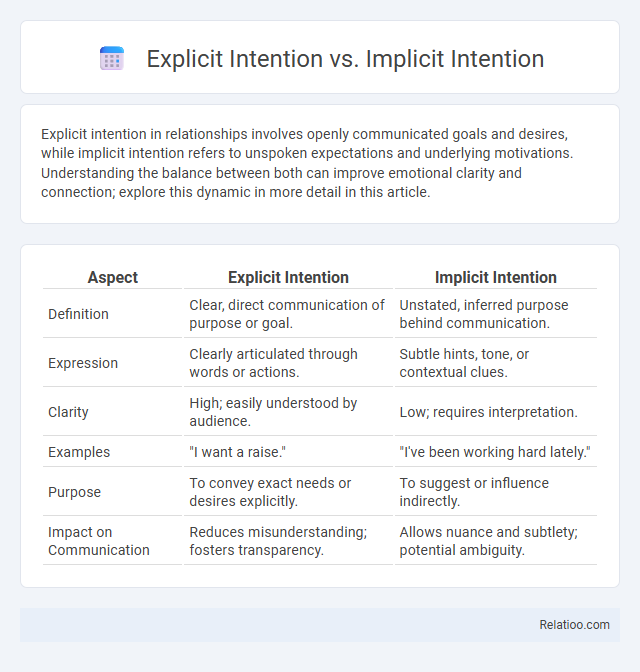Explicit intention in relationships involves openly communicated goals and desires, while implicit intention refers to unspoken expectations and underlying motivations. Understanding the balance between both can improve emotional clarity and connection; explore this dynamic in more detail in this article.
Table of Comparison
| Aspect | Explicit Intention | Implicit Intention |
|---|---|---|
| Definition | Clear, direct communication of purpose or goal. | Unstated, inferred purpose behind communication. |
| Expression | Clearly articulated through words or actions. | Subtle hints, tone, or contextual clues. |
| Clarity | High; easily understood by audience. | Low; requires interpretation. |
| Examples | "I want a raise." | "I've been working hard lately." |
| Purpose | To convey exact needs or desires explicitly. | To suggest or influence indirectly. |
| Impact on Communication | Reduces misunderstanding; fosters transparency. | Allows nuance and subtlety; potential ambiguity. |
Defining Explicit Intention
Explicit intention refers to a clearly defined and consciously acknowledged goal or purpose that guides decision-making and behavior. Unlike implicit intention, which operates subconsciously and influences actions without overt awareness, explicit intention involves deliberate planning and articulation of desired outcomes. Understanding your explicit intentions allows for targeted efforts and measurable progress toward achieving specific objectives.
Understanding Implicit Intention
Understanding implicit intention involves recognizing the underlying motivations or goals that are not directly communicated but inferred from context or behavior. Unlike explicit intention, which is clearly stated, implicit intention requires interpreting subtle cues, such as tone, body language, or situational factors, to grasp the true purpose behind actions. Your ability to discern implicit intention enhances communication effectiveness and helps avoid misunderstandings by addressing unspoken needs or desires.
Key Differences Between Explicit and Implicit Intention
Explicit intention involves a conscious, deliberate decision to perform a specific action, clearly articulated and acknowledged by the individual. In contrast, implicit intention operates below the level of conscious awareness, influencing behavior through unconscious motives or automatic tendencies. The key difference lies in awareness and control, with explicit intention being intentional and self-directed, while implicit intention shapes actions indirectly without conscious recognition.
Psychological Foundations of Intention
Explicit intention involves conscious and deliberate planning toward specific goals, whereas implicit intention operates below conscious awareness, influencing behavior through automatic processes. The psychological foundations of intention encompass both cognitive control mechanisms and motivational states, integrating conscious decision-making with unconscious influences to drive goal-directed actions. Understanding the interplay between explicit and implicit intentions is critical for modeling human behavior, self-regulation, and adaptive functioning in complex environments.
Real-World Examples of Explicit Intention
Explicit intention involves clearly stated goals or desires, such as a company publicly announcing its plan to reduce carbon emissions by 2030. Implicit intention refers to underlying, unstated motives inferred from actions, like an employee working late hours to gain favor without verbalizing the ambition. Your understanding of these distinctions is enhanced by real-world examples where explicit intentions are documented, providing tangible evidence of commitment and strategic direction.
Real-World Examples of Implicit Intention
Implicit intention manifests in real-world scenarios where actions imply purpose without verbal acknowledgment, such as a driver slowing down near a school to signal caution without explicitly stating the intent. In workplace settings, a manager assigning tasks without direct orders may reveal an implicit intention to delegate responsibility and encourage autonomy. These examples highlight how implicit intention guides behavior and communication through unspoken cues and contextual understanding.
The Role of Intention in Communication
Intention in communication shapes the meaning and effectiveness of messages, distinguishing explicit intention, where the purpose is clearly stated, from implicit intention, which relies on context and inference. Explicit intention ensures clarity and reduces misunderstanding by directly conveying the communicator's goals, while implicit intention requires the receiver to interpret underlying motives, often enriching the interaction through shared knowledge. Understanding these variations enhances communication strategies by aligning sender and receiver interpretations for more precise information exchange.
Impact on Human Behavior and Decision-Making
Explicit intention clearly guides your actions by defining specific goals, leading to more deliberate and focused decision-making processes. Implicit intention influences behavior subconsciously, often shaping choices through underlying motivations without conscious awareness. Understanding the distinction between explicit and implicit intentions enhances insight into how different types of intentions drive human behavior and impact the outcomes of decisions.
Measuring and Identifying Intentions
Explicit intention refers to clearly stated goals or desires easily identified through direct communication or overt actions, enabling straightforward measurement using surveys or self-reporting tools. Implicit intention involves subconscious or unarticulated motives, often revealed through behavioral analysis, physiological indicators, or machine learning algorithms detecting patterns in decision-making processes. Measuring intentions effectively requires integrating explicit declarations with implicit signals to provide a comprehensive understanding of the underlying purpose driving human actions.
Applications and Implications in Everyday Life
Explicit intention involves consciously setting clear goals, improving your focus and decision-making in tasks like planning and communication. Implicit intention operates beneath awareness, influencing habits and automatic behaviors such as driving or social interactions, often guiding actions without deliberate thought. Understanding both types of intention enhances self-awareness and helps optimize daily routines, productivity, and interpersonal relationships.

Infographic: Explicit Intention vs Implicit Intention
 relatioo.com
relatioo.com